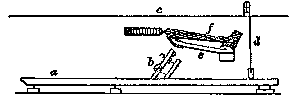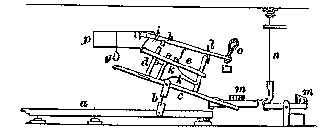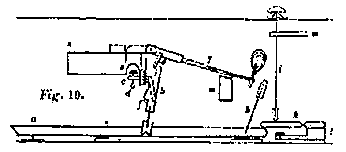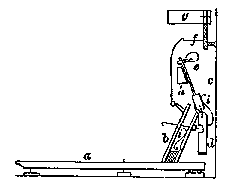
PIANO-FORTE, a keyed musical instrument, variously formed and under different denominations, such as grand, square, and upright. The first notion of the square pianoforte was taken from the clavichord by a German mechanic of the name of Viator, about ninety or a hundred years ago ; but, for want of friends or funds, he never became known as a maker. The invention however was followed up by other musical instrument makers of the same nation, who all left their clavichords and harpsichords for the new instrument, the piano-forte. Thus we have Zumpe, Tabel, Schudi, Kirkman, Broadwood, Stodart, Schoene, Buntebart, Pohlman, Pather, Beek, Gareha, Ganer, and a host of others.
The grand piano-forte is supposed to be of earlier date than the square piano-forte, and is said to have been the invention of a German musician of the name of Schr÷der, or, as others say, of Christofali, a harpsichord-maker of Padua. The first maker at all known in this country was a German of the name of Backers, but we are not aware that success attended his exertions with the solid advantages which were enjoyed by his contemporary Zumpe, who realised an ample fortune, and retired. The place of his retirement we well remember, and have heard good report of his cheerful glass and well-filled pipe, without which, in those days, a German did not acknowledge that he lived. The grand piano-forte retains the shape of the instrument from which it was taken, the harpsichord ; and although that shape has been much condemned, we have never been able to see any other objection to it than its largeness ; it is the natural outline of the instrument, and we do not think that a better form for it will ever be devised.
The square piano-forte, we have said, was taken from the clavichord, but it retains only its shape, with the same disposition of the strings and keys ; their actions have no similarity. The action of the clavichord was simply a piece of brass pin wire, which was placed vertically at a point where it could be struck or pressed against its proper string, the right-hand division of which was free to vibrate, whilst the left-hand was muffled by a a piece of cloth, the object of which was to damp or stop the string, which it did the instant the finger was taken off the key. The touch of the clavichord was peculiar, partaking both of the harpsichord and the organ ; in other words, both struck and pressed, and the pressure could be so varied as to produce a kind of treblant effect. The tones were feeble, soft, and melancholy, and better suited to the student, the composer, or the solitary, than any purposes of social amusement.

a, Key. b, Brass pin wire. c, String. d, Cloth woven between the strings as a damper.
The action of the square piano-forte, on its first introduction, consisted of a key, a lifter, a hammer, and a damper. The key was the same as that of the clavichord. The lifter was a brass wire, with a piece of hide leather as a head, which was covered with a piece of soft leather as a finish. This lifter, when in motion, struck the hammer against the string, and thus produced the tone of the instrument. The damper followed the performer, and stopped the vibrations as quickly as the finger was removed fromt he key. (See fig. 2.) The tone of this piano-forte was thin and wiry, the hammer having only one slight covering of sheep-skin leather upon it.

a, Key. b, Lifter. c, String. d, Damper. e, Damper stick or mopstick. f, Hammer. g, Lifter. h, Brass damper.
This rude idea of a piano-forte continued in use for many years, and the first improvement upon it was introduced by Longman and Broderip, who brought out a patented invention having two additional parts in the action, namely, the hopper and the under-hammer, as they were called (see fig. 3.). This patent was followed by another introduced by Clementi and Co., the burden of which simply was an improvement on the damper. It was called the Irish patent, from its having been the invention of an Irishman of the name of Southwell ; but it had simplicity only to recommend it, was found inconvenient, and shortly afterwards was superseded by what is now called the crank damper. We cannot give the name of the inventor of this improvement ; it became so instantaneously general, that the inventor was lost sight of in the crowd of makers who adopted his invention. It is still in use, and is acknowledged to be a good and sufficient plan. The damper used by Messrs. Broadwood previously to the introduction of the crank damper was made in brass (see fig. 2), but by whom invented we do not know. We now come to the last addition which has been made to the action of the square piano-forte, the check. This member was borrowed from the grand piano-forte, and is so acknowledged by the name given to those square piano-fortes which have it ; for they are always called, par excellence, grand-square piano-fortes. The check certainly is a most important part of a piano-forte, and the best of actions is nothing without it. The check is placed behind the hammer, nearly at thee end of the key ; where, after the blow has been given, it catches the tail of the hammer, and holds it till another blow is required (see fig. 3). For further information as to the square piano-forte, we refer to the diagrams, which we hope will be found sufficient for any information that may be required. As an instrument, we think less of the square piano-forte than any other : it has neither the touch, the tone, nor the appearance of either the grand or the upright.
Fig. 3, exhibiting all the Varieties of the modern Piano-forte as respects the Action.

a, Key. b, Hopper, by which the escape of the hammer is effecte[]. d, Irish damper. dd, Crank damper. e, Under hammer j[] g. Check.
The grand piano-forte, as above observed, was th[] tion of Schr÷der or Christofali, manufactured by [] and retains the shape of the instrument from whi[] taken, the harpsichord. Here again we have tw[] ments alike in form, but unlike in almost ev[] circumstance ; for their action, their tones , and th[] which they are played upon, are all entirely differe[] action of the harpsichord was simply a key and [] called a jack, which was a piece of pear-tree wi[] moveable tongue of holly, through which a cutting [] quill was passed to touch the string when the jac[] action ; the tone produced by this contrivance w[] of scratch with a sound at the end of it (see fig. 4[]
Fig. 4. Harpsichord Jack.

a, Jack. b, Tongue. c, Quill. d, Bristle spring. e, Cloth dam[]
The action of a grand piano-forte consisted of a [] lever, a hammer, a button, a check, and a damp[] rails and sockets to connect them. By this combin[] parts, every musical intention known or desired [] time was perfectly attainable, and with admirable ef[] Mozart, Haydn, Cramer, and others (see fig. 5). [] have now new and more severe judges to encounter : [] actions are no longer sufficient ; new effects are to b[] and new powers are called for. Fortunately, the[] have been accomplished, for new actions have rise[] abundance, and we have only to choose between[] The more or less of excellence will, doubtless, oec[] puzzle the amateur, but some ready-fingered frien[]quaintace may be called in, and the difficulty is [] removed by a single cadence on the instrument [] whether major or minor is quite immaterial.
No musical instrument is so universally admired [] piano-forte. Its compass, whether six octaves, si[] half, or seven, is sufficient for all purposes of music []position, and may really be considered a miniature []tra. The smaller instruments have generally [] octaves, the grands have six octaves and a hal[] octaves we have not yet learned to admire. The s[] the early piano-fortes were parly of steel and partly [] the treble notes of steel, and the lower notes of bra[] of which, in the bass, were over-lapped or covere[] open, with plated-copper wire to give them more [] according to the length attainable in the instrument [] modern piano-fortes have steel wire throughout, wit[] and octave in the bass closely lapped with unwashed []e. The strings which are now used in piano-fortes are []siderably larger than those which wer formerly used ; []advantages of which are durability and firmness. The []-wire now in use is the manufacture of Mr. Webster of []bs, near Birmingham, and is greatly superior to the []ce -famed German wire, now no more in esteem with []glish manufacturers, from the bad quality of the metal [] the very imperfect manner in which it was drawn : when []fectly round, which it ought always to be, it was gene-[]ly too soft ; and when sufficiently hard, it was scarcely []er well manufactured, from which circumstance it was []nstantly false in vibration. Stops and pedals are more or []s adopted in different countries. Stops can scarcely be []d to be used at the present day ; they properly belong to []e middle age of piano-forte making, and were placed in the []ument on the left hand of the performer. The damper-[]op raised the dampers froom the strings, which gave con-[]uation to the tones, and the buff-stop raised a piece of []ft buff leather up to the strings, and gave the instrument []what the tone of the harp. Pedals are much esteemed []some performers and little by others ; in foreign piano-[]rtes we find many pedals, but in English we have []ely ever more than two - one for piano effects , and the []er for forte. This pedal, the forte, is an effective pedal []d not at all injurious to the mechanism of the instrument [] not say as much of the piano pedal, for, by passing motion to one string, it is not only straining to the []res of the hammers, but is also very apt to disturb the tu-[] of the unisons, by which an instrument is often unfairly []d as regards its standing, and a more frequent applica-[] to the tuner is required. In lieu of this pedal, some [] have introduced a soft substance, wool or leather, []ween the hammers and the strings, by which something []ke []buff-stop is accomplished, but with more delicacy []vibration in its effects. The foreign name for this []l is jeu cÚleste, and to us it is more agreeable, and is []inly less injurious to the action of the instrument than []re frequent piano pedal.
We will here give, in alphabetical order , a few diagrams []f grand actions. Their merits we must leave to those who []occasion for them, reserving only the right to make a []w brief remarks that may be necessary for the purpose of []is article. They are the works of living manufacturers.
Fig. 5. The Common Grand Piano-forte Action.

a, Key. b, Lever. c, Button. d, Check. e, Damper. f, String. g, Ruler. []Damper pedal lifter. iii. Rails and sockets. k, Spring. l, Hammer.
Fig. 6. Messrs. Broadwood's former and new Patent Grand Action. (Invented by Mr. Southwell, son of the late Mr. W. Southwell.)
The shaded parts are the new additions, the intention of which is to keep the hammers at a certain distance from the string when the finger is on the key.


a, Key. b, Lever. c, Button. d, Check. e, Damper. f, String. g, Crank [] Damper. h, Damper pedal lifter. iiii. Rails and sockets. k, Spring. l, Hammer. m, n, Block passed through the hammer butt. o, Spring fixed at the back of n, and pressing upon the front of it ; but hwich arrangement, when the lever passes the notch, it is caught by m, and the hammer is sustained at the given height. p, Another spring, which regulates the action of o, and determines the height it shall rise.
Fig. 7. Messrs. Collard and Collard's new Patent Grand Piano-forte Action ; the Invention of Mr . George Stewart.

a, Key. b, Hopper. c, Button. d, Hopper spring. e, Hamer. f, Check. g, Hammer rail. h, Dammper. ii, Rail and socket. k, Crank for damper. l, Damper pedal lifter.
Fig. 8. Mr. Errard's Patent Grand Action ; the Invention of his Uncle, Mr. Sebastian Errard.

a, Key. b, Lifter centred in the key and hopper lever. c, Hopper lever. dd, Hopper. e, Hammer sustaining lever. f, Stop for e. g, Hopper button. h, Butt for the hopper to hit against. ii, Two small wire stops acting upon z. kk, Hopper and sustaining spring. l, Check. mm, Balance weights of lead. n, Damper. o, Hammer. p, Hammer rail.
Fig. 9. Mr. Wornum's new Grand Action. (This Action is based on the Piccolo Action.)

a, Key. b, Hopper and spring. c, Hammer. d, Check. e, Button to set off the hopper. f, Hopper lever. g, Tie attached to the butt of the hammer. h., Sustaining spring linked to the end of the tie, and fixed in the from end of the hopper lever, the rising of which puts the sustaining spring in action. This spring fives the piano blow and assists in the forte and repetition. ii, Damper and fixings. h. Hammer ruler and back touch. l, Wood spring to set up the hoppers.
Fig. 10. Mr. Zeiter's new Grand Action.

a, Key. b, Hopper, which works in the key with what is called a bird's mouth. c, Escapement part of the hopper and the setting off is effected by the button working in the arched part above it, d. e, d, Button and wire. e, A [] in which the button acts. f, Hopper string. g, Hammer. h, Check. i, Damper. k, Damper Crank. l, Damper pedal action. mm, rail and socket. n, Hammer rail.
The upright piano-forte was, doubtless, taken from the upright harpsichord, and we have always understood that it was the invention of an Englishman of the name of Hancock, a musical insturmetn maker resident in some part of Westminster. He was a man of much ingenuity, and produced several varieties in keyed instruments ; amongst which we find the organized piano-forte, the portable grand piano-forte, and an instrument, also a piano-forte, in the shape of a spinnet. The portable grand, in its day, was successful and desirable instrument, but has long since been superseded by instruents of the kind called kit grands, boudoir grands, pocket grands, and semi grands. The next novely was the invention of John Isaac Hawkins, who constructed an upright instrument with a detached sound-board in an iron frame, and the whole was so arranged as to be able to meet the atmosphere with compensating powers. In the bass, it had spiral or helical strings, by which length was gained ; and in the treble, three octaves of equal tension were accomplished by a uniform size of wire. It was patented, but did not take with the public sufficiently to come into notice. Following Hawkins we had William Southwell, who patented an improvement in upright piano-fortes, and gave it the name of the cabinet piano=forte. The name still remains amongst us, but the invention has long since been superseded and laid aside. The unique piano-forte was introduced about thirty years ago by Messrs. Wilkinson and Wornum, and was the invention and patent of the latter. This instrument met the taste of the day for instruments of little altitude ; it did not stand higher than three feet three inches, and the strings were all placed diagonally towards the floor ; the action was simple and effective, but is not now under manufacture.
Fig. 11. Mr. Wornum's Patent Unique Action.

a, Key. b, Hopper. c, String. d, Hammer rail. e, Hammer..f, Damper and wire. g, Damper rail. h, [Rails]. ii, springs.
Numerous inventions and improvement appeared about this time, some of which were patented, and some not : but we cannot say more concerning them than that they were productions with scarcely a difference, and calculated merely to gratify their several makers with a avariety of their own : for thier powers and peculiarities were all much to the same effect under the finger of a performer : indeed we had no decidedly new thing until the double or Piccolo action appeared. This was the invention of Mr. Wornum, and patented by him some ten or twelve years ago ; it is applicable to both upright and horizontal instruments, and is now extensively manufactured in Europe and America.
Fig. 12. Mr. Wornum's double or Piccolo Action.

a, Key. b, Hopper and spring. c, Hammer. d, Hammer rail. e, Tie and wire. f, Check. gg, Damper and wire. h, Setting off screw.
For delicacy, promptness, and firmness of touch, it has not yet been equalled.
There are many things relaing to the piano-forte which we have not touched upon. There are aso some foreign actions to which we have not given much attention, especially those called down-striking actions ; we have seen these, but are decidedly of opinion that they never will receive sufficient approbation to come into general use : they are much lumbered with parts, and all have a bad touch, which, in the present age of performers, whose effects are so delicate and so rapid, is alone to condemn them. Other inventions too, such as Mr. Lithehrland's patent helical springs to preserve the tuning , Mr. Riley's transposing instrument, Mr. Mott's sostinente, Mr. Kirkman's octave string, and Mr. John Trotters alternated key-board, have all given place to other things, and are no longer known in the present generation of musical people. Mr. Litherland's plan was a well-tempered helical spring, which was to be attached to the loop of the strings ; thus, as the strings contracted the spring gave way, or as it expanded the spring collapsed, by which the pitch of the string was retained and the tuning consequently preseerved. It was never adopted to any great extent, but had its admirers : a want of firmness in the tone was perhaps its greatest defect. Mr. Riley's plan for transposition was simply a double set of keys, on sliding under the other, by which music might be played from the same scale a note or notes higher or lower. It was purchased by Messrs. Broadwood, and is now laid aside. It never was calculated to be of service to the practice of music ; neither did it introduce any new or valuable idea to the mechanic. Mr. Mott's
There is one other point, to which we would draw attention, and that is what is called the bracing of piano-fortes. Our inquiries have led us to this subject, and we find that in flat instruments, especially grands, there is a difficulty in giving strength to the bracing . Some makers are for iron, and some for wood ; but wood, it seems, is inconvenient, and iron is therefore mostly adopted. That strength is important, and very important, is quite clear, when we know that the strings of a grand piano-forte pull equal to a weight of six tons. Iron as a substance, doubtless, has the greater strength, but may not wood be so applied as to be strong enough? That wood is more sonorous than iron, there has never, we believe, been a question. and we will yet hope that sooner or later it will be allowed to be a better material. The ingenuity and capital now employed in this interesting branch of manufacture give us some promise that the day is not far distant when a more uniform and successful practice will be adopted in the construction of the pianoforte. If this can be accomplished, what may not be expected from future Hummels and Thalbergs?